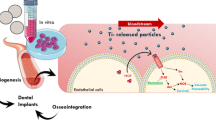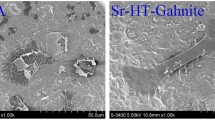Abstract
The promotion of early osseointegration is crucial for the success of biomedical titanium implants. Physical and chemical modifications to the material surface can significantly compensate for the lack of biocompatibility and early osseointegration of the implant. In this study, we implanted strontium onto titanium plates and analyzed the effect of strontium-doped materials on angiogenesis and biocompatibility in the human bone structure. Our findings demonstrated that strontium-loaded titanium sheet materials effectively promote human umbilical vein endothelial cell (HUVEC) biocompatibility and vascular differentiation ability, as evidenced by proliferation-apoptosis assays, RT-qPCR for vascular neogenesis markers, ELISA for vascular endothelial growth factor (VEGF) levels, and nitric oxide (NO) analysis. Mechanism studies based on RNAseq and Western blotting analysis revealed that strontium can promote titanium material biocompatibility with HUVEC cells and vascular neovascularization ability by activating the extracellular signal-regulated kinase 1/2 (ERK1/2) signaling pathway. Meanwhile, blocking the ERK1/2 signaling pathway could reverse the promotional effect of vascular formation. Overall, we have successfully fabricated a multifunctional biocompatible bone implant with better histocompatibility and angiogenesis compared to uncoated implants.







Similar content being viewed by others
Data Availability
The data that support the finding of this study are available from the corresponding author upon reasonable request.
References
Huang P et al (2004) Surface modification of titanium implant by microarc oxidation and hydrothermal treatment. J Biomed Mater Res B Appl Biomater 70(2):187–190. https://doi.org/10.1002/jbm.b.30009
Spriano S et al (2018) A critical review of multifunctional titanium surfaces: new frontiers for improving osseointegration and host response, avoiding bacteria contamination. Acta Biomater 79:1–22. https://doi.org/10.1016/j.actbio.2018.08.013
Andersen OZ et al (2013) Accelerated bone ingrowth by local delivery of strontium from surface functionalized titanium implants. Biomaterials 34(24):5883–5890. https://doi.org/10.1016/j.biomaterials.2013.04.031
Sun Y-S et al (2015) Nanoporous surface topography enhances bone cell differentiation on Ti–6Al–7Nb alloy in bone implant applications. J Alloy Compd 643:S124–S132. https://doi.org/10.1016/j.jallcom.2015.01.019
Loi F et al (2016) Inflammation, fracture and bone repair. Bone 86:119–130. https://doi.org/10.1016/j.bone.2016.02.020
Di Maggio N, Banfi A (2022) The osteo-angiogenic signaling crosstalk for bone regeneration: harmony out of complexity. Curr Opin Biotechnol 76:102750. https://doi.org/10.1016/j.copbio.2022.102750
Diomede F et al (2020) Functional relationship between osteogenesis and angiogenesis in tissue regeneration. Int J Mol Sci 21(9):3242. https://doi.org/10.3390/ijms21093242
Geng Z et al (2022) Optimizing the strontium content to achieve an ideal osseointegration through balancing apatite-forming ability and osteogenic activity. Biomater Adv 133:112647. https://doi.org/10.1016/j.msec.2022.112647
Geng Z et al (2018) Nanosized strontium substituted hydroxyapatite prepared from egg shell for enhanced biological properties. J Biomater Appl 32(7):896–905. https://doi.org/10.1177/0885328217748124
Geng Z et al (2021) A novel snail-inspired bionic design of titanium with strontium-substituted hydroxyapatite coating for promoting osseointegration. J Mater Sci Technol 79:35–45. https://doi.org/10.1016/j.jmst.2020.11.041
Huang D et al (2020) Strontium-substituted sub-micron bioactive glasses inhibit ostoclastogenesis through suppression of RANKL-induced signaling pathway. Regen Biomater 7(3):303–311. https://doi.org/10.1093/rb/rbaa004
Saidak Z, Marie PJ (2012) Strontium signaling: molecular mechanisms and therapeutic implications in osteoporosis. Pharmacol Ther 136(2):216–226. https://doi.org/10.1016/j.pharmthera.2012.07.009
Gu Z et al (2013) Acceleration of segmental bone regeneration in a rabbit model by strontium-doped calcium polyphosphate scaffold through stimulating VEGF and bFGF secretion from osteoblasts. Mater Sci Eng C Mater Biol Appl 33(1):274–281. https://doi.org/10.1016/j.msec.2012.08.040
Weng L et al (2017) Binary doping of strontium and copper enhancing osteogenesis and angiogenesis of bioactive glass nanofibers while suppressing osteoclast activity. ACS Appl Mater Interf 9(29):24484–24496. https://doi.org/10.1021/acsami.7b06521
Kuo YJ et al (2022) Angiogenesis, osseointegration, and antibacterial applications of polyelectrolyte multilayer coatings incorporated with silver/strontium containing mesoporous bioactive glass on 316L stainless steel. Front Bioeng Biotechnol 10:818137. https://doi.org/10.3389/fbioe.2022.818137
Zhu X et al (2019) Influence of strontium on vascular endothelial growth factor and fibroblast growth factor 2 expression in rat chondrocytes cultured in vitro. Biol Trace Elem Res 190(2):466–471. https://doi.org/10.1007/s12011-018-1564-y
Sun Y et al (2021) A polydopamine-assisted strontium-substituted apatite coating for titanium promotes osteogenesis and angiogenesis via FAK/MAPK and PI3K/AKT signaling pathways. Materials Science and Engineering: C 131:112482. https://doi.org/10.1016/j.msec.2021.112482
Almubarak S et al (2016) Tissue engineering strategies for promoting vascularized bone regeneration. Bone 83:197–209. https://doi.org/10.1016/j.bone.2015.11.011
Filipowska J et al (2017) The role of vasculature in bone development, regeneration and proper systemic functioning. Angiogenesis 20(3):291–302. https://doi.org/10.1007/s10456-017-9541-1
Yang F et al (2023) Biodegradable magnesium incorporated microspheres enable immunomodulation and spatiotemporal drug release for the treatment of osteonecrosis of the femoral head. Composites Part B: Engineering 250:110430. https://doi.org/10.1016/j.compositesb.2022.110430
Choudhary S et al (2007) Strontium ranelate promotes osteoblastic differentiation and mineralization of murine bone marrow stromal cells: involvement of prostaglandins. J Bone Miner Res 22(7):1002–1010. https://doi.org/10.1359/jbmr.070321
Bonnelye E et al (2008) Dual effect of strontium ranelate: stimulation of osteoblast differentiation and inhibition of osteoclast formation and resorption in vitro. Bone 42(1):129–138. https://doi.org/10.1016/j.bone.2007.08.043
Montagna G et al (2020) An in vivo comparison study between strontium nanoparticles and rhBMP2. Front Bioeng Biotechnol 8:499. https://doi.org/10.3389/fbioe.2020.00499
Kołodziejska B, Stępień N, Kolmas J (2021) The influence of strontium on bone tissue metabolism and its application in osteoporosis treatment. Int J Mol Sci 22(12):6654. https://doi.org/10.3390/ijms22126564
Barbeck M, et al. (2022) In vivo analysis of the immune response to strontium- and copper-doped bioglass. In Vivo 36(5): 2149–2165. https://doi.org/10.21873/invivo.12941
Fotopoulou C et al (2022) Outcomes of gynecologic cancer surgery during the COVID-19 pandemic: an international, multicenter, prospective CovidSurg-Gynecologic Oncology Cancer study. Am J Obstet Gynecol 227(5):735.e1-735.e25. https://doi.org/10.1016/j.ajog.2022.06.052
Ha KJ, Kim N (2014) Regulation of NFATc1 in osteoclast differentiation. J Bone Metab 21(4):233–241
Zhang W et al (2018) Synergistic effect of strontium and silicon in strontium-substituted sub-micron bioactive glass for enhanced osteogenesis. Mater Sci Eng C Mater Biol Appl 89:245–255. https://doi.org/10.1016/j.msec.2018.04.012
Yuichiro T, Tomoko M, Yuji Y (2015) Functional diversity of fibroblast growth factors in bone formation. Int J Endocrinol 2015:729352
Saito M et al (2018) Platelet-derived TGF-β induces tissue factor expression via the smad3 pathway in osteosarcoma cells. J Bone Miner Res 33(11):2048–2058
Funding
This work was supported by Natural Science Foundation of Hebei Province Youth Science Foundation Project (Grant numbers H2020109157).
Author information
Authors and Affiliations
Contributions
All authors contributed to the study conception and design. Material preparation, data collection, and analysis were performed by Jianjun Jiao, Bingkun Cheng, QingYong Chen, Jiahuan He, and Xueqiang Zhang. The first draft of the manuscript was written by Bingkun Cheng, Jiahuan He, Qingqing Cui, and Chao Ma. All authors commented on previous versions of the manuscript. All authors read and approved the final manuscript.
Corresponding author
Ethics declarations
Ethics Approval
NA. There is no human or animal subject involved in the research.
Competing Interests
The authors declare no competing interests.
Additional information
Publisher's Note
Springer Nature remains neutral with regard to jurisdictional claims in published maps and institutional affiliations.
Rights and permissions
Springer Nature or its licensor (e.g. a society or other partner) holds exclusive rights to this article under a publishing agreement with the author(s) or other rightsholder(s); author self-archiving of the accepted manuscript version of this article is solely governed by the terms of such publishing agreement and applicable law.
About this article
Cite this article
Cheng, B., Chen, Q.Y., Zhang, X. et al. Improved Biocompatibility and Angiogenesis of the Bone Titanium Scaffold through ERK1/2 Signaling Mediated by an Attached Strontium Element. Biol Trace Elem Res 202, 1559–1567 (2024). https://doi.org/10.1007/s12011-023-03772-3
Received:
Accepted:
Published:
Issue Date:
DOI: https://doi.org/10.1007/s12011-023-03772-3




